|
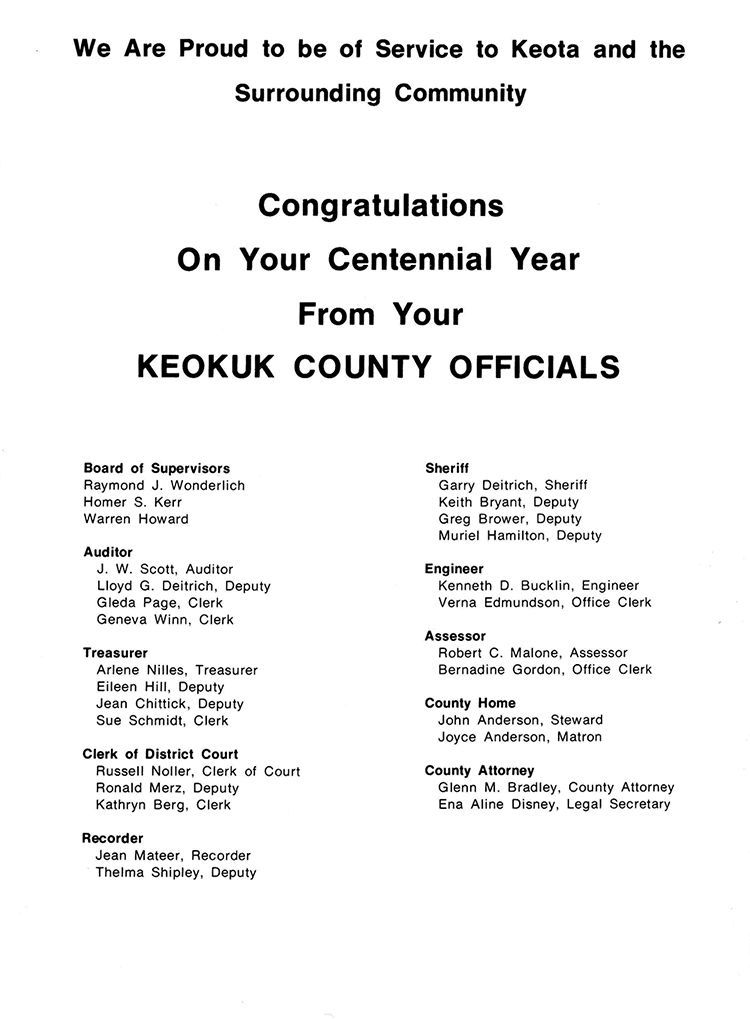
61
A glimpse into the past...
OVER THE YEARS
The Same Business...The Same Name...The Same Family
THE HULSE FAMILY
A. A. Hulse General Store
Mrs. Ruby Hulse
Helscher, present owner of the A. A. Hulse Store in Keota, is a
daughter of Addison Hulse who in 1887 erected the present store
building. The firm has operated continuously under this name at this
location on Broadway, Keota's main street.
When the town of
Keota was incorporated in 1873 young "Add," then 14, began work in the
Spangler Store.
His father,
Minard A. Hulse, and his brother-in-law, J. A. Y. Ashby, in 1883 opened
a general merchandising business with "Add" as chief clerk. His wage of
$10 weekly was tops in that day. Their store called the Western Store
was located a block west of today's store.
Ashby quit the
firm four years later and Add," then 22, became his father's partner.
The elder Mr. Hulse wished his son to manage the business and changed
the firm name to A. A. Hulse and Company.
When a saloon
burned down at the site of today's store, "Add" planned purchase of the
lot and the new structure.
For 85 years the
business was continued. Addison's widow, Mrs. Georgia Ramsey Hulse, was
owner during her lifetime with her son-in-law, the late Will Helscher,
as manager. Following her death Will and Ruby Helscher purchased the
store.
Since Will's
death, 14 years ago, Ruby has carried on the business founded by her
father and in which her late husband was associated for about 50 years.
He was first an employee, then was manager after A. A. Hulse's death in
1919, until the death of Mrs. Hulse in 1947 when "Will and Ruby" became
owners.
To Ruby, sole
owner today, the store is more than a business, since childhood it has
been an intimate thing. Little girl memories include coaxing Daddy for
a ride on the store's sliding ladder. She says that after two or three
rides his refusal of "No more" was adamant.
As a clerk she
says the grinding by hand of coffee for customers was tedious and on a
five pound order was plain tiring. She counted eggs brought packed in
oats to prevent breakage on the long rough ride to town. Occasionally
she found tiny eggs and even stones that had been substituted for eggs.
The farm family
of the horse and buggy days drove to town weekly to "trade out" their
produce. On many Saturday nights the store remained open for business
until after midnight.
Eighty-five years
ago the Hulse Store was fronted by a board walk and hitch-racks. The
building has since been extended to the alley and remodeling includes a
modern window front. There have been dramatic changes in heating,
lighting, and transportation and a surfaced highway has replaced the
mud street.
But the policy of
the store has remained unchanged.
The Hulse Store
since its founding has placed a weekly ad in the town paper, The Keota
Eagle. The earliest ads were terse statements found in the column of
locals because the paper was a small one with only four pages.
This is from
1887, quote: "Go to A. A. Hulse & Co. for the Keota Roller Mill
Flour. We will put it against any other flour in the market."
The following
year there appeared a square boxed advertisement written in a variety
of lettering to make it easy to read and it was not unattractive. It
read. Quote: "Energy, Enterprise and stock to back them are what have
made A. A. Hulse & Co. the leaders of General Merchandise and they
propose to hold the advantage gained by having at all times the latest
styles, the best quality, the lowest prices on everything." With a
larger paper came the display ads so common today.
In a half page as
of March 20, 1899, are these Easter items: Ladies' ready made dress
skirts from $1.39 to $6.00. Fancy short capes with snug ribbon ruching
collars from $1.39 to $7.50.
The delivery of
groceries has never been discontinued. Triweekly deliveries are made on
Mondays, Wednesdays and Saturdays.
Through the years
some lines have been dropped: shoes, coats, ladies hats, carpeting,
linoleum, and curtains and others. Frozen and packaged goods have
replaced groceries from the open barrel. Natural gas today is a far cry
from the early-day woodburning stoves and air conditioning has been
added. "The passing of the cookie barrel was one change that saddened
me," says Ruby, "because in that early day each child who came into the
store was given a cookie. How I missed seeing the smiles of the kiddies
for that cookie."
Another pertinent
comment by Mrs. Helscher is that in the modern Super-Market offering a
variety of merchandise is doing what the country store has always done.
Assisting Mrs.
Helscher in today's store is Mrs. Ruth Ginkens as full -time clerk with
Mrs. Helen Mills, Mrs. Betty Heisdorffer, and Mrs. Verne McConnell as
part-time clerks, who still serve the customers by approaching them
with words that never lose their aptness, "May I help you?"
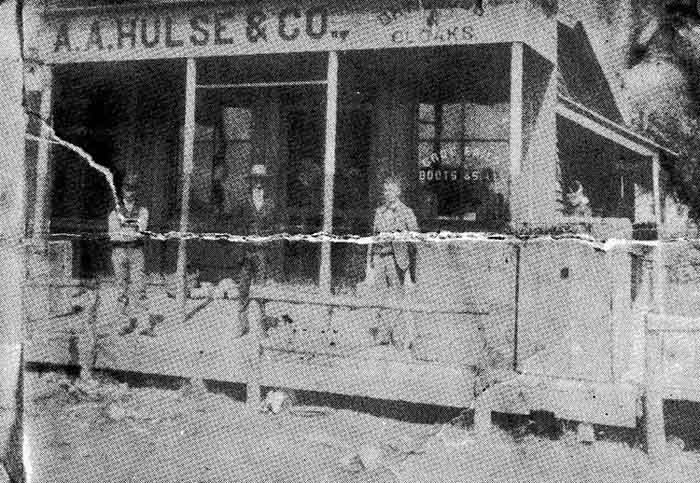
Left to Right — A. A. Hulse, M. A. Hulse, Elmer Hulse.
62
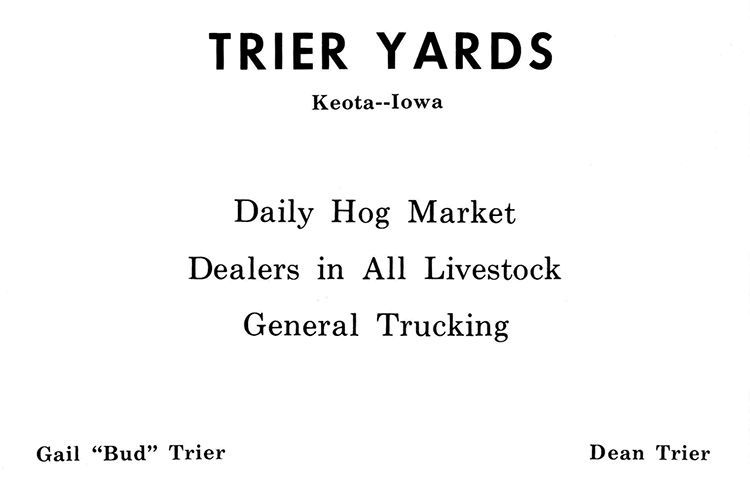
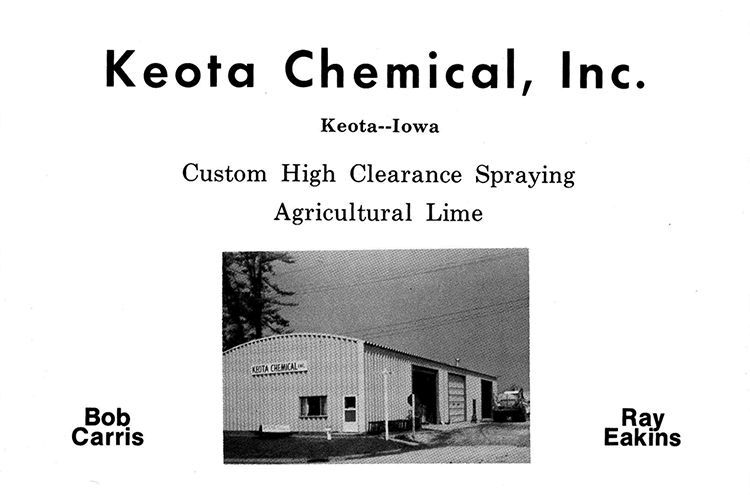
63
A glimpse into the past...
INDUSTRY
THE C.R.I. AND
P. RAILROAD
The Chicago, Rock
Island and Pacific Railroad had, for a number of years, been operating
a road to Washington and repeated offers were made from time to time to
induce the said Company to extend the line to the county seat of Keokuk
County. In the fall of 1870 Ebenezer Cook, Vice-President of this
Company, made a proposition to build the road provided the people of
the county would raise by subscriptions the sum of $50,000.00, secure
the right-of-way from the Washington County line and to provide
suitable depot grounds. The committee to whom the people had delegated
the management of this matter consisted of J. P. Yerger, J. H. Shawhan
and George D. Woodin. This committee on canvassing the matter wrote to
Mr. Cook, stating that his proposition would be accepted, but they
preferred to raise part of the subsidy by taxation, in several
townships under the laws of Iowa, instead of by subscription. To that
the Rock Island Company consented, agreeing to take the amount assessed
as a part of the $50,000.
In January, 1871,
elections were held in the several townships of the county which would
be immediately benefited by the building of the proposed road. Among
these were Lafayette Township. The vote was in favor of the tax, and
through the energetic efforts of the committee the right-of-way was
soon secured and depot grounds located.
Hosea Newton and
J. Sherman, very early settlers in the Keota area, were on hand and
laid the first rail for the railroad in Keokuk County. Hanno Newton,
son of Hosea, rode the first train that crossed Clear Creek west of
Keota. The first lumber which was brought into Keota by train was March
1, 1872. The depot, 22 x 24, was well built and was conveniently
located in the middle of Fulton Street. April 21, 1872, was the
"opening up" date of the railroad through Keota.
The C.R.I. &
P. R.R. has for the past 101 years been servicing the town of Keota.
However many changes have been made.
HAPPENINGS
ALONG THE KEOTA BRANCH OF THE C.R.I. & P. RAILROAD
September 16 to
21, 1878. Iowa State Fair held in Cedar Rapids. Round trip from Keota
to Cedar Rapids and return - $3.60.
A. L. Lindner,
Agent.
August 26, 1882.
Special trains to the State Fair at Des Moines will be run September 4,
5, 6, 7 and 8 as follows: Leave Keota, 6:03 A.M.
Arrive at Des Moines at 10:35 A.M.
Returning leave
Des Moines, 7:15 P.M.
Arrive at Keota, 12:17 A.M.
No baggage will be carried
on these trains.
A. L. Lindner, Agent.
August 19, 1882.
Excursion tickets to the Keokuk County Fair at Sigourney will be sold
August 22 to August 25, inc. Good to return on or before August 26.
Fare for round trip, 55 cents.
September 9,
1882. The Rock Island road has still further reduced its fare to
Chicago; rate now being from Keota to Chicago — $7.63.
1887. Keota has
eight trains a day — four freight, two passenger and two mail trains.
October 24, 1890.
Keota railroad station is now a coupon ticket office and is prepared to
check baggage and sell through tickets to all points in the United
States and Canada.
July 6, 1891. Due
to the railroad strike on the Rock Island, Keota is experiencing a very
dull time. Mail service is erratic and Sunday papers arrive Thursday.
Freight traffic is dead. The branch plug train has been making daily
runs minus its sleeper. The Eagle is a few days late caused by the
delay of its Chicago print getting through the blockade. The strike
caused many a Fourth to fizzle out this year. Harper and Sigourney
failed to receive their fire works and several of the orators failed to
arrive.
December 24,
1897. The Rock Island management has caused a 14-section sleeper to be
operated on this branch instead of the l0-section Pullman heretofore in
use because of increasing travel.
February 25,
1898. Keota is a good business point. Recently 16 travelers got off the
train and stampeded Landlord Willis of the Columbia Hotel.
May 19, 1902. We
have a Pullman sleeper on our train now.
January 9, 1908.
The Firefly made its last run through here Saturday. We now have two
passenger trains through here a day. On Monday, August 9, the "Firefly"
was put back in service. We can now take in chautauquas in Columbus
Junction and Washington. The mail service will also be resumed.
October 10, 1912.
Keota station on the Rock Island is becoming important. They now have a
telegraph operator, agent and helper. Earl Blythin is now operator.
May 7, 1914. The
Rock Island has raised the fare from Keota to Washington from 29¢ to
30¢. Its property around here certainly looks like 30¢ and such a
brazen attempt to enrich its stockholders at the expense of the people
ought to make it feel like 30¢.
May 20, 1926. The
new motor car service on the Knoxville branch of the Rock Island
through Keota started Monday morning. It is an interurban car with
power and passenger space combined in one car. It also has a baggage
room, which is used as a smoker because the car hauls the regular mail
and baggage car. The car is of the gas-electric type, operating from an
8-cylinder gasoline engine which runs a dynamo, which in turn generates
electricity. The seats carry three persons each and capacity is 48
people.
April 21, 1927.
The "Galloping Goose" will be replaced Saturday with a 72' all steel
electric car. There is a ten foot engine room in front, express
compartment 11 1/2 ft., smoking compartment 9 ft. and the main
compartment is 38 ft. seating 77 passengers. The exterior is of olive
Duco, interior trim of Honduras mahogany, floors of rubber tile and
linoleum, seats of muleskin leather and it is heated by
64
A glimpse
into the past...
|
hot water. It has basket fixtures, drinking
fountains and toilet facilities.
October 23, 1930. Otto and Stanley Jackson of
Oskaloosa were granted permission from the railroad commission to serve
the town of Keota on a passenger bus line which they operate between
Washington and Oskaloosa.
December 21, 1944. The Rock Island sent one of its
Rocket passenger trains through Keota Sunday night at 11:40 causing
quite a sensation among those living near the railroad to hear and see
it. It went through here at about 20 miles per hour, honking for all
the crossings, pulling about seven brightly lighted Pullmans full of
passengers who didn't look up or know what a thrill the railroad's
neighbors in Keota were getting.
|
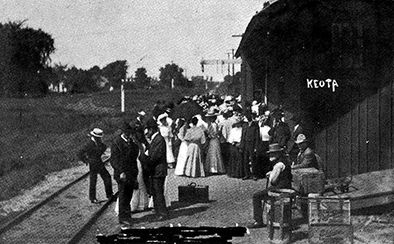 |
|
THE DEPOT
May 24, 1895. A petition has been signed by a
number of our citizens to have the depot removed from the center of
Fulton Street where it now stands. It is the central street of the town
that leads direct to the park.
November 1, 1895. The depot has been moved and a
square box, supposed to be a bay window, has been stuck on the south
side. New flooring of hard wood will be put in. The old platforms have
been rebuilt. The old shanty will be repainted and made to look like
new again.
March 8, 1906. Several Rock Island engineers were
here and took measurements in and around the railroad yards. It is
supposed the Rock Island is about to build a "house track" on the north
side of the station for relief of freight crews who are badly put out
by passenger trains butting in at a time when they are busiest
unloading their wares.
|
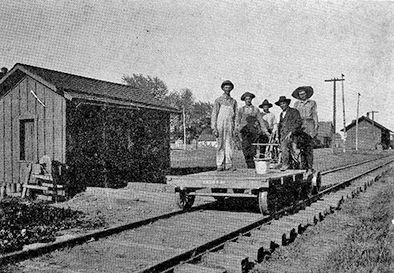 |
|
October 26, 1906. Six men are working on the new
station
platform. It is to be brick immediately in front of the depot
and the balance on either end to be of cinders. They unloaded several
cars of cinders and sand yesterday. The
curbing plank is four inches thick.
May 16, 1907. Warren Stewart tells us he first
came to Keota May 13, 1872. The railroad was built through the town and
the depot half up. J .T. Webber was the agent. There was no end to the
mud. Keota is bad enough now in a wet time, but in those times without
a foot of drainage anywhere it must have been fierce.
The Keota Depot was torn down in March 1971.
|
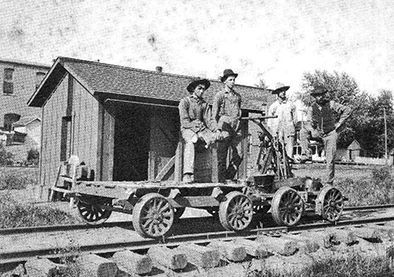
C R I & P section crew. House pictured in the right background
believed to be the old "Everett House". |
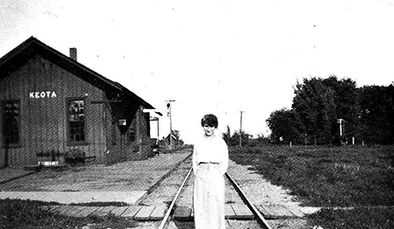 |
**********
July 9,
1931. Mr . and Mrs. John (Jane McCully) Vincent who were pioneers of
Washington County were killed in a railway accident when the wagon in
which they were riding was struck by a train at what is since known as
the Dick Fisher crossing about four miles east of Keota. The accident
occurred in 1876 and was the first fatal accident to occur on the new
railroad which was built in 1872.
|
65
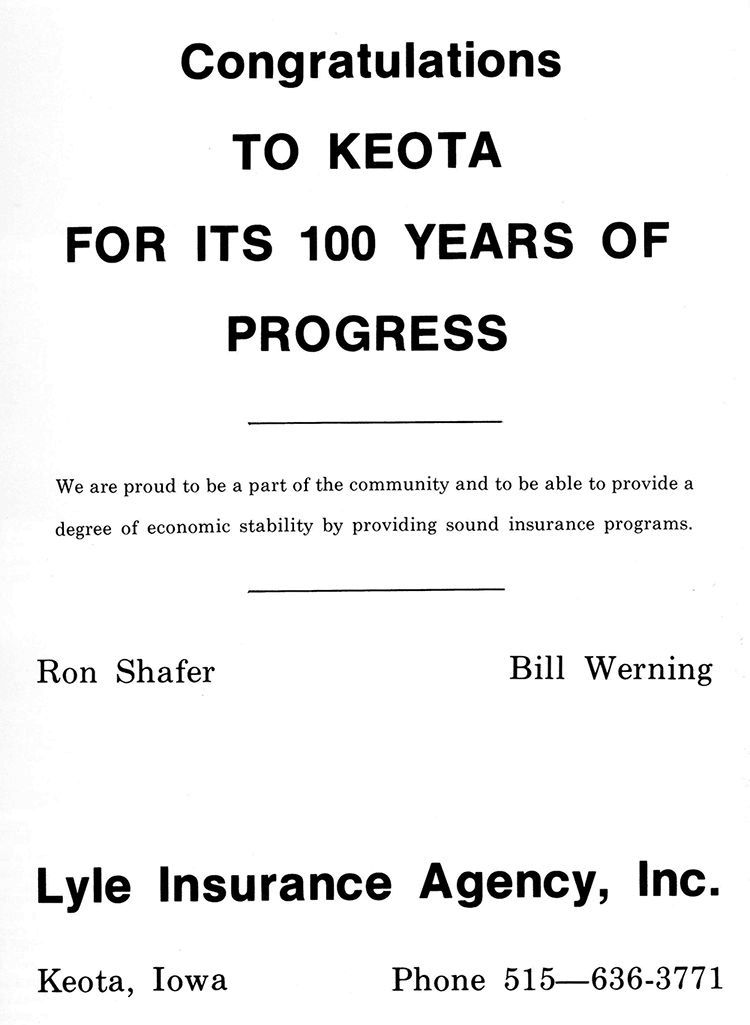
66
A glimpse
into the past...
ORGAN FACTORY
In the spring of
1873, Dave Wolfe of near South English built the home known later as
the Stephens property, north of the U. P. Church. (This is now
approximately the Bill Ross property). He started a planing mill on the
lot north of his house, for the purpose of dressing native lumber from
the saw mills along the Skunk River. Among the boards brought in were
five specimens of walnut and Mr. Wolfe saw the opportunity of using
this material in the manufacture of organ cases and other fine cabinet
work. The keyboards, reeds and inside works of organs were secured in
the East and assembled here.
In 1901 there
still remained one of the organs in a home here. It was given to J.M.
Wilcox. In 1875, Mr. Wolfe's brother, James, became a partner and they
established a foundry, turning out grey iron castings. The editor of
The Keota Eagle in 1934 states that Frank Glover, Mack Snider and
several others well remember the pioneer days in Keota of the Wolfe
Bros. Foundry and Organ Factory.
In another
article it is noted that Jerry Wolfe who lived north of South English
was a carpenter, cabinet maker and surveyor in early days when Keota
was started and he helped build the first building erected here in
1872. Then he worked for a year or more in the Keota Organ Factory.
Probably not many of the present generation, says the editor of The
Keota Eagle in 1934 knew that Keota had an organ factory and it turned
out a lot of organs. He states that it would be interesting to know if
any one in the community has a Keota built organ. The Eagle would be
glad for this information.
It is also noted
that May 1, 1880, The Burdette Organ Company of Keota sued the Estey
Company for infringing on their patents and recovered $160,011.71
damages.
**********
June 1876. Wagon
& Carriage Maker — L. P. Dull. Keota Wagon Shop — A. S. Vincent.
December 9, 1876.
The Keota Foundry is in full running order. They have made two
successful blasts and are now ready to furnish anything in the cast
iron line that may be ordered.
1879. The
Carriage Works, H. A. Millhouse. Makes first class carriages and
buggies. Spring wagons a specialty. Shop west of the Post Office.
1880. Keota
Carriage Factory on East Broadway. We make a specialty of building and
repairing all kinds of buggies. Buggies and Carriages always in stock.
Van Winkle Bros. & Co.
July 1880. A new
industry in Keota. Two men are manufacturing spring beds. They make
them on a new and improved plan.
February 4, 1882.
The "Leacox Washington Machine" is being manufactured in Keota by H. T.
Divelbiss.
March 21, 1885.
KEOTA CREAMERY. Mr. U. L. Williams has his creamery building nearly
ready for the machinery which will be here this week. He has closed out
the grocery business and will devote full time to the creamery: On
Monday the Keota Creamery shipped 54 tubs of butter to New York.
September 5,
1885. Mr. W. A. Eastlake is the new owner of the creamery. He comes
highly recommended as a butter maker.
February 20,
1886. Keota Creamery to be sold at Sheriff's Sale.
August 26, 1887.
The Keota Roller Mills, under Henkle, Tallman and Co., have been
extensively remodeled arid approved. There are now nine sets of rollers
and a new machine for extracting cockle seed. They also can steam hard
flinty wheat (as produced this season) and bring it to the rollers so
good flour can be guaranteed. It now has a capacity of 125 barrels per
day of 24 hours.
January 31, 1890.
The Keota Roller Mills have had plenty of ups and downs but believe it
has now started on road to prosperity. Keota Mills have had reputation
of making fine flours and Henkle and Bush, owners, intend to keep the
record. Mr. Ehrlick is the new miller. Minnesota hard wheat is used.
"Crystol Patent" is the name of the flour.
July 25. 1890.
The entire "innards" of the Keota Mill will be moved to Weiser, Idaho.
It's a good mill for such poor wheat country as this, the machinery
being the most expensive kind and the only way to make money was to
keep it going day and night and to have home wheat to grind which could
not be done here. Keota needs a mill, and a plant can be put here for
one-third the cost of the old one.
February 21,
1890. The mill ordered a 125 horse power engine. After this engine is
put in Keota Roller Mills will have but few equals in matter of
equipment.
July 22, 1892.
Acme Butter Factory. Acme Butter Factory was incorporated with its
principal place of business in Washington Co., adjacent to the town of
Keota. Board of directors are: R.T. Carris, L.W. Muttal, J.F. Anderson,
D.W. Wolfe, H.P. Newton, E.B. Brown, and H. Henkle. The president is
R.T. Carris; vice president, L.W. Nuttal; treasurer, H. Henkle;
secretary, H.P. Newton.
March 29, 1895.
The Keota Produce Company recently incorporated and will st art
business next Monday. The Acme Factory building will be the scene of
operations, it and the Keota Creamery having been merged into one. S.E.
Reisman will supervise and Mr. Carpenter will assist.
April 1, 1898.
Keota has a cigar factory now open for business in the Eaton Building
on East Broadway. Mr. H. Tschanz is an experienced maker of the
"fragrant weed." Fine Havana and Domestic cigars are manufactured here.
67
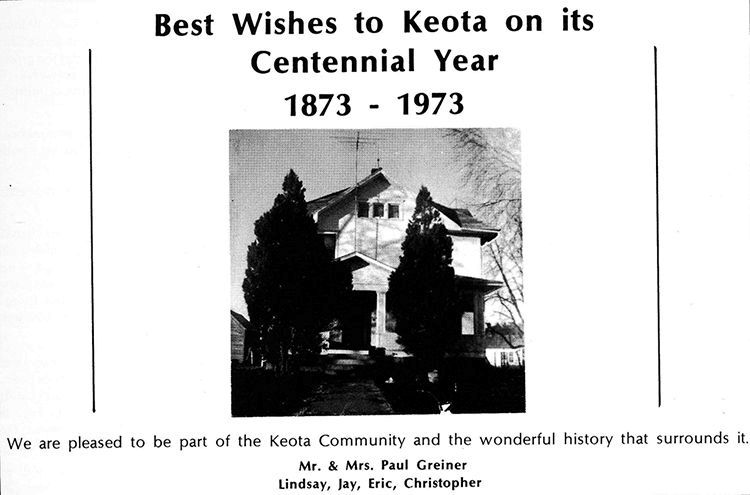
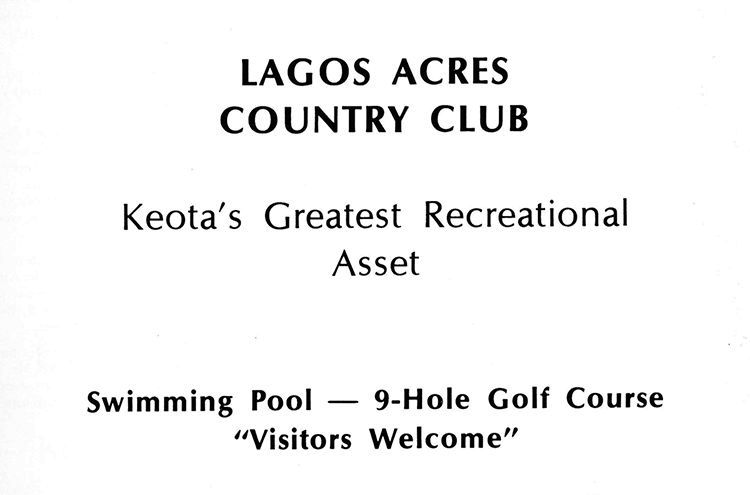
68
A glimpse into the past...
April 16, 1936.
The Keota Produce Company's hatchery is a busy place right now as the
baby chick season approaches its height and is furnishing local
employment and an outlet for hatching eggs from certified flocks. The
hatchery's capacity is 12,000 chicks. It is located in a room specially
constructed for the purpose at the Keota Produce Company.
June 18, 1936.
Keota Creamery will be opened June 20. George Haberman of Elma, Iowa,
having secured co-operation of the Keota Community Club, bought the
Statler brick building on Broadway and has re-constructed it
throughout. He drilled a well over 300 feet deep to furnish clean water
for cooling, cream. The product of the local creamery will be called
"Keota Butter." It will be on sale at Keota stores and shipments will
be made to New York markets.
March 18, 1937.
Charles D. Kirkpatrick was voted a 14 month lease on the old town hall
at the council meeting. Mr. Kirkpatrick will begin to use it late this
summer for approximately a year for sorting and storing hybrid seed
corn of which he will plant a large acreage this year. When the busy
season arrives in the seed corn business he will employ several men in
the storage room and if his first year's experience is successful his
seed corn business will very possibly become an important and permanent
industry for the town and community.
October to, 1940.
The Land O' Lakes turkey plant in Keota began operations Monday morning
and is employing 80 persons. There are 58 women employed and 22 men, of
whom some are skilled workers who were brought in from elsewhere. The
first carload of 1124 large turkeys was packed by Tuesday afternoon and
shipped out by refrigerator car that night. A. Bernstein is the manager
and is well satisfied with the way the plant is operating. The turkey
plant is located in the Berend Building on West Broadway.
May 21, 1942.
Locust Grove Turkey Farm Goes All Out On War Production. Ed. L.Conrad,
owner of the Locust Grove Turkey Farm, operates 40,000 capacity
Jamesway incubators, specializing in hatching turkey poults. Besides
selling poults to his customers, he raised over 8,000 meat birds last
year, dressing out over 20 carloads of turkeys a year in their modern
dressing plant. They do all their marketing through the Land O' Lakes
Creameries.

KEOTA TILE
FACTORY
December 8, 1883.
KEOTA TILE FACTORY. Mr. E. A. Kennel has purchased two acres of land
from the Mill Company, just south of the mill, and will be here soon to
begin building. He took a sample of the clay to the Illinois Zinc Works
to be tested and they pronounced it the best tile clay ever brought to
them for testing. The Tile Factory is now a reality. The Railroad
officials have agreed to put in a side track to the factory.
December 29,
1883. E. A. Kennel, the tile factory man, returned from Muscatine with
a sample tile made from Keota clay. It makes a strong smooth tile and
burns a nice red color. He will now make arrangements for building the
factory.
June 6, 1885. Our
tile manufacturers have added a tile mill and crusher and have ordered
brick for a new kiln.
October 24, 1885.
Proprietors of Keota Tile are putting steam pipes in their sheds to
enable them to run in the winter.
June 26, 1886.
This factory now represents a cost of $12,000, and with one exception
is the largest tile factory in Iowa. The main part of the building is
32 x 84 feet and 10 feet to the eaves — it is fitted with steam pipes
for heating and drying. The west wing is 18 x 60 feet and two stories
high; east wing 18 x 80 feet, and 12 feet to the eaves.
The grinding
power is fitted with a 35 horse power engine and 50 horse power boiler.
The machine used is the Bennett Brick & Tile Machine, which has a
capacity of 10,000 three inch tile per day — 8000 four-inch or 6,000
five-inch tile per day.
The products of
this machine are burned in two huge, down draft kilns, lined on the
inside with fire brick. This enterprise started in the spring of 1884.
Twelve to 15 hands are now employed. Mr. E. A. Kennel and J. C. Clarke
are principal proprietors.
May 5, 1910.
Keokuk and Washington counties will soon be connected by a subway or
underground railway. S.K. Leacox is building a tunnel across the road
from the tile factory to land in the other county and will henceforth
make tile and brick out of Washington Co. clay. Leacox said the tunnel
will be 66 feet in length, the width of the road, with 10-foot
approaches and in diameter it will be 5.2 by 6 feet. Sam hasn't decided
on the kind of power he'll use to run his trains.
March 16, 1911.
BUILDING BLOCKS. S. K. Leacox will manufacture hollow building blocks
at his factory this year. He got the molds last week. The blocks are
made of clay and are like those used in school houses.
May 3, 1923. Ed
Lantry, manager of the Keota tile factory, has ads in the paper warning
parents to keep their boys out of the tile factory pit as there is
danger of them being killed. The clay cars weigh from 800 to 900 lbs,
and pass thru the tunnel under the county road with tremendous speed.
The tunnel is just big enough to clear the car.
69
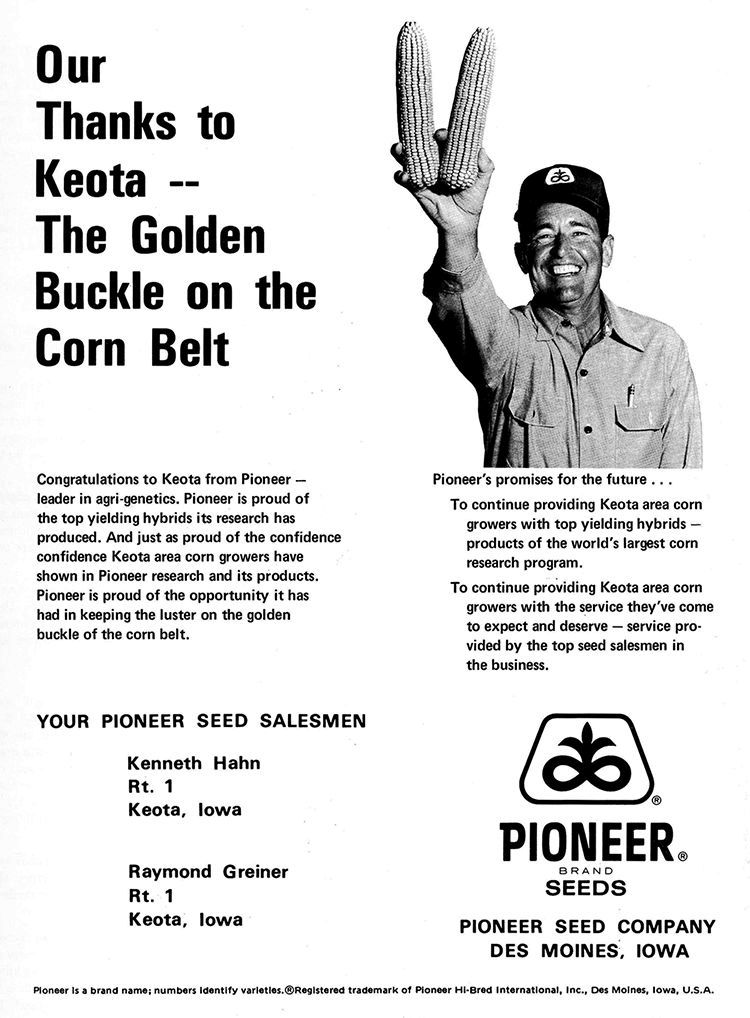
70
|